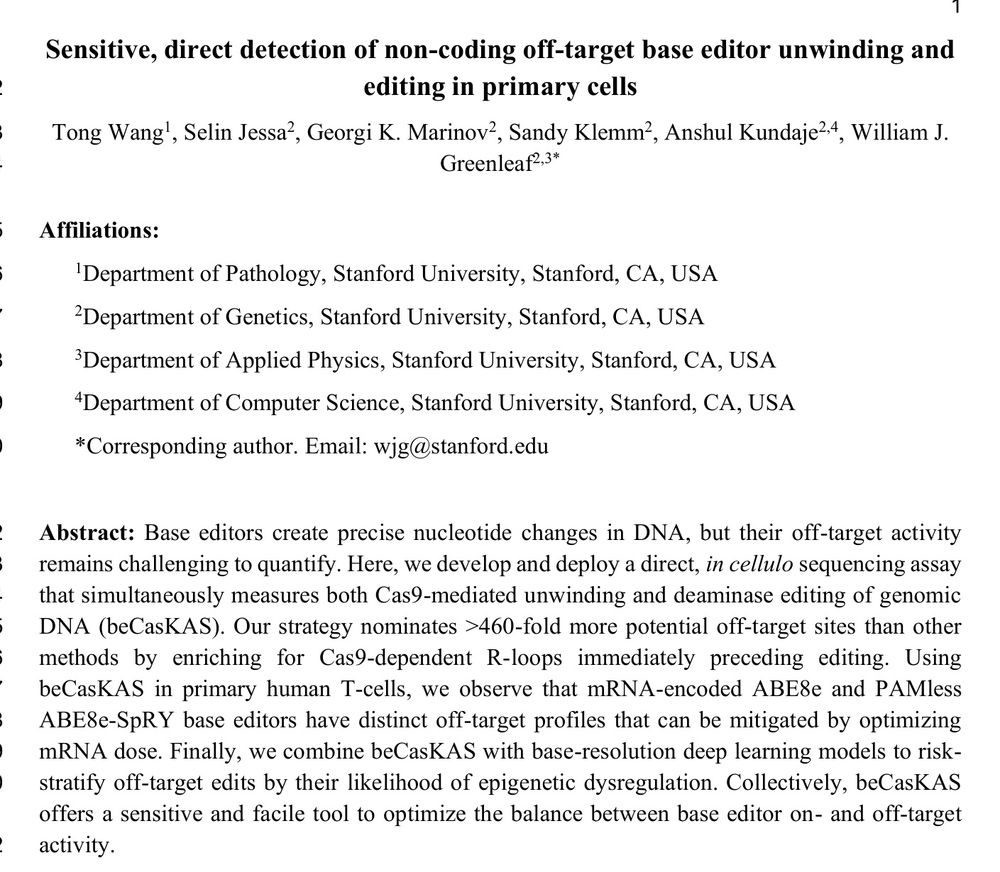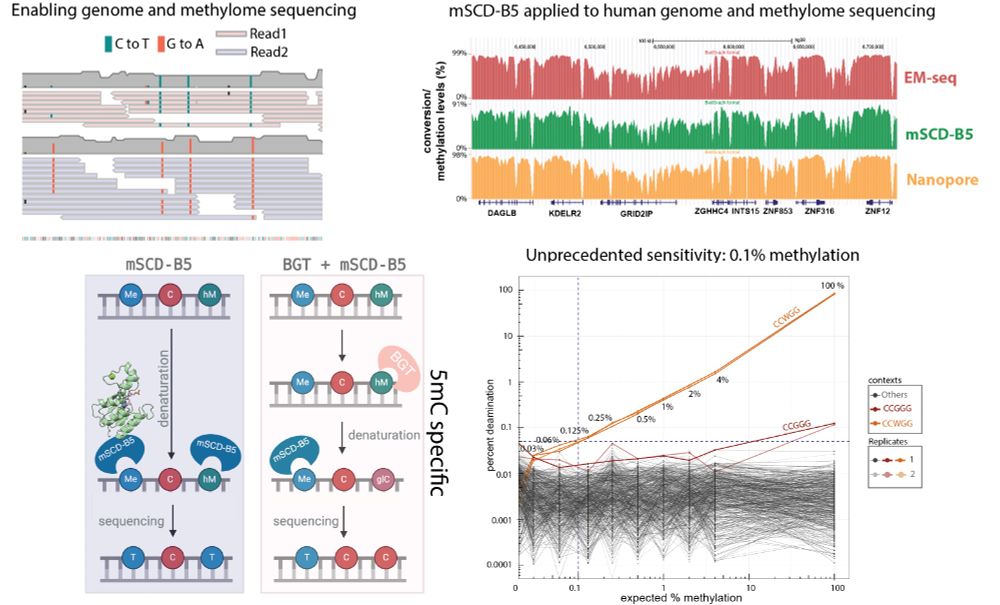
Sounding Board
"Nearly 30 years after the sequencing of the human genome, bespoke therapies are close to reality. The FDA will work as a partner and guide in ushering these therapies to market, and our regulatory strategies will evolve to match the pace of scientific advances."
"FDA’s New Plausible Mechanism Pathway Vinay" by Prasad, M.D., M.P.H., and Martin A. Makary, M.D., M.P.H.
Personalized therapies hold tremendous promise but challenge traditional models of drug and biologic development. The @fda.gov outlines a path to market entry for products where a randomized trial is not feasible. Learn more: nej.md/4nUQdcl
12.11.2025 22:40 — 👍 1 🔁 3 💬 1 📌 1
After leukemia treatments failed, Alyssa Tapley, at age 13, was told she would die. Then, doctors tried an experimental gene-edited therapy. She became the first human to try the treatment made possible by U.S. federal funding. Now 16, she’s cancer-free and planning her future.
10.11.2025 00:33 — 👍 112 🔁 22 💬 3 📌 3

The Editor Got a Letter From ‘Dr. B.S.’ So Did a Lot of Other Editors.
The Editor Got a Letter From ‘Dr. B.S.’ So Did a Lot of Other Editors.
The rise of artificial intelligence has produced serial writers to science and medical journals, most likely using chatbots to boost the number of citations they’ve published
#GiftLink
www.nytimes.com/2025/11/04/s...
07.11.2025 22:21 — 👍 39 🔁 10 💬 2 📌 1

Erythroblast ChromBPNet model predicts impact of known therapeutic CRISPR target (exagamglogene autotemcel, Casgevy) on accessibility a) Schematic of Casgevy mechanism. BCL11A represses fetal hemoglobin in adulthood. Disruption of a BCL11A enhancer reactivates fetal hemoglobin. b) Observed ATAC and predicted accessibility from ChromBPNet BCL11A intron, for T-cells (this study) and erythroblasts 48. c) Predicted accessibility for chr2 60495264: T>C edit and reference sequence in erythroblasts, along with DeepLIFT contribution scores. d) Predicted accessibility of chr2 60495267: T>C edit and reference sequence in erythroblasts. The ABE8e edit window is derived from the highest efficiency gRNA sg1620
We then used sequence-to-activity deep learning models, to predict effects of non-coding edits on TF binding and chromatin accessibility. We first show that a ChromBPNet model can predict the same GATA site disruption mechanism exploited by the FDA-approved Casgevy medicine, specifically in T cells:
07.11.2025 18:38 — 👍 0 🔁 1 💬 1 📌 0
A highlight of my summer was this collab w/
@twangmdphd.bsky.social ! CRISPR base editors are driving several clinical trials, but it's hard to quantify off-target edits and their effects. Tong developed a sequencing assay to identify off-targets *in primary cells* 🧬🖥️🧪 #genomics #chromatin #CRISPR
07.11.2025 18:38 — 👍 4 🔁 2 💬 1 📌 0

Sensitive, direct detection of non-coding off-target base editor unwinding and editing in primary cells

Figure 1

Figure 2

Figure 3
Sensitive, direct detection of non-coding off-target base editor unwinding and editing in primary cells [new]
Direct seq. quantifies off-target base editor & DNA unwinding.
26.09.2025 04:54 — 👍 0 🔁 1 💬 0 📌 0
Sensitive, direct detection of non-coding off-target base editor unwinding and editing in primary cells https://www.biorxiv.org/content/10.1101/2025.09.25.678665v1
26.09.2025 04:33 — 👍 0 🔁 1 💬 0 📌 0
8/ This was a group effort drawing expertise from different parts of the Greenleaf Lab and the larger Stanford Genetics community. A big thank you to @selinjessa.bsky.social, Georgi, Sandy, and @anshulkundaje.bsky.social I am especially grateful to Will for encouraging me to take on this project.
29.09.2025 18:28 — 👍 2 🔁 0 💬 0 📌 0
7/ There’s much more in the preprint (deep learning of novel T-cell non-coding off-targets, SpRY editors, and comparisons to other methods to name a few), but I won’t give it all away here. Base editors hold immense promise, and we hope our insights help to improve them.
29.09.2025 18:28 — 👍 1 🔁 0 💬 1 📌 0

6/ We also show how deep learning can predict the effects of non-coding edits. Here, an erythroid but not T-cell model predicts loss of DNA accessibility upon editing. The model learns the GATA motif driving this prediction. This site is of course the intended target of Casgevy.
29.09.2025 18:28 — 👍 1 🔁 0 💬 1 📌 0

5/ We extensively optimized beCasKAS to be compatible with primary human T cells and 5moU mRNA delivery. Transient mRNA delivery limits off-target formation, which can be further mitigated by carefully selecting mRNA dose.
29.09.2025 18:28 — 👍 0 🔁 0 💬 1 📌 0

4/ We are able to see the known strand-specific editing patterns of two contrasting editors: eBE (using hAPOBEC3A) and ABE8e. Using plasmid delivery in HEK293Ts, we find these two editors have surprisingly similar absolute editing frequencies.
29.09.2025 18:28 — 👍 0 🔁 0 💬 1 📌 0

3/ beCasKAS makes two measurements at each off-target site. The unwound R-loop appears as a peak, and individual edits appear as mismatched nucleotides.
29.09.2025 18:28 — 👍 0 🔁 0 💬 1 📌 0

2/ We use an N3-kethoxal pulldown probe because it has the same selectivity for ssDNA as the deaminases used in base editing. The cell permeable kethoxal allows us to enrich for unwound Cas9 R-loops that must occur before DNA editing. This selectivity underlies our sensitivity.
29.09.2025 18:28 — 👍 0 🔁 0 💬 1 📌 0

1/ Happy to share our preprint from the Greenleaf Lab: beCasKAS, our method to directly detect CRISPR base editor off-targets in primary cells. We additionally show how non-coding edits can be triaged for epigenetic dysregulation using deep learning.
www.biorxiv.org/content/10.1...
29.09.2025 18:28 — 👍 12 🔁 4 💬 1 📌 1

www.biorxiv.org/content/10.1...
Our study published today on #bioRxiv describe the identification of a deaminase that converts 5mC to T, enabling direct sequencing of the human methylome and genome. This achievement was made possible through a collaborative effort across all departments at #NEB.
09.12.2024 14:12 — 👍 113 🔁 57 💬 5 📌 6

(1st post @BlueSky) Preprint alert🚨a long thread. Cautions in the use of @nanopore sequencing to map DNA modifications: officially reported “accuracy” ≠ reliable mapping in real applications. We performed a critical assessment of nanopore sequencing (across different versions of models) for the 1/n
20.11.2024 11:41 — 👍 115 🔁 44 💬 6 📌 10
who knew it would be easier to get everyone to switch social media platforms than getting them to use hg38
14.11.2024 18:45 — 👍 254 🔁 62 💬 15 📌 13
Data Scientist Generative AI @BayerCropScience. ML for Plant Biology. PhD @IowaStateUniversity https://www.linkedin.com/in/koushik-nagasubramanian/
Thinking about messy data.
[Unbreaking](https://unbreaking.org/) & [CU Boulder's Info Visions Lab](https://infovisions.github.io/)
(extricated from afgoldfarb on 🐦, was once goldfarb.bsky.social 🦋)
Associate Professor, Biochemistry and Biophysics,
University of Rochester. RNA-targeting CRISPR / CRISPR membrane proteins / RNA acetylation. An Aussie in 'the land of the free'. Music Nerd
Clinical Pathologist: Transfusion Medicine Fellow and Postdoctoral Researcher at Columbia University Medical Center
Biochemist, structural biologist, sometimes bacterial geneticist
CRISPR Chief Technology Officer
Alum: @HuidaGene @ExcisionBio @CRISPRTx @GeorgiaTech @SangamoTx @UIowa @UCSF @MIT Posts = own.
Bioengineer | CRISPR-Cas genome editor
Currently building cell & gene therapies
PhD from Doudna Lab @ UC Berkeley & UCSF
Forbes 30u30 ‘24 | NIH F31
Senior Researcher at @LUMC_Leiden I @RENEW_Global | Genome Editing | Biochemistry | CRISPR-Cas
RNA and programmable nuclease innovator 🧬 | R&D leader in amplification-free molecular detection systems ⚙️ | Consulting to bridge enzyme science, business & strategy 🧪 | Amateur bulldog whisperer 🦴
Prof. and Head of Phage-host interactions (Phi) lab. Phage defences, counter-defences, CRISPR-Cas, toxin-antitoxin. FRSNZ / James Cook Fellow
PhD Candidate in the Fineran Lab - studying the type I-D CRISPR-Cas system 🦠👩🏼🔬
📍University of Otago, Dunedin, NZ 🇳🇿
A leading Cell Press reviews journal (2024 IF- 19.9) covering topics in drug development, pharmacology, therapeutics, pharmaceutics and toxicology.
Biochemist, PhD 🇱🇹 | Postdoc at UCPH 🇩🇰 Taylor lab
| CRISPR-Cas, TA systems, structural bio (X-ray, cryo-EM).
Runs, black humor 🏃👟💣
Scientist. Asst Prof at Stanford Chemistry and Stanford Med Microbiology & Immunology. Mama to 2. dassamalab.org
Assistant Professor at Columbia Chemistry. PI of a chemical biology lab full of awesome people. Internal conflicts: Chemist or biologist? Kinase or phosphatase?
Lab website: https://shahlab.wixsite.com/home
ORCiD: 0000-0002-1186-0626
Assistant Professor, Stanford University Dept. of Chemistry and Sarafan ChEM-H | Chemical biology, synthetic biology | Small molecules, large molecules, biological mechanisms
Assistant Professor, UW-Madison Chemistry. Group website: http://martellgroup.chem.wisc.edu.
Pediatric Hematologist/Oncologist, Geneticist, Stem Cell Biologist
bloodgenes.org
Synthetic biology and gene regulation
Aka DJ Fishing Expedition
Bioengineer at MIT
Harvard + Johns Hopkins alum
vikashchauhan.com
https://scholar.google.com/citations?user=eg-K9EoAAAAJ&hl=en
Our vision of enabling researchers to rapidly move from the lab to life-changing advances reflects our commitment to a healthier, brighter future for all. 🧬

















